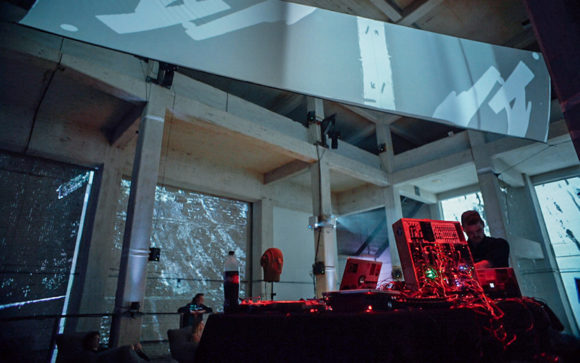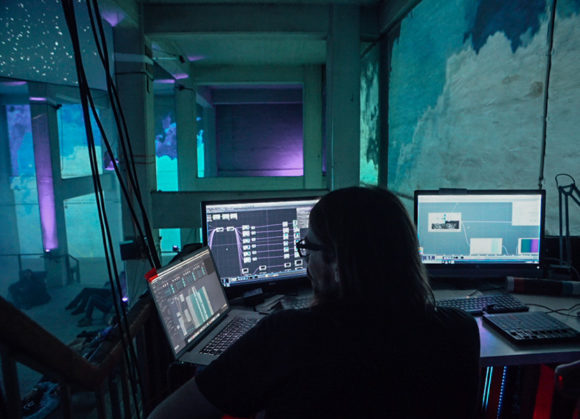
As part of our ongoing support of emerging artists, Native Instruments partnered with the University of Applied Sciences Europe and Tech Open Air to present RE/VOLVE, a far-reaching inter-disciplinary programme exploring spatial audio-visual design and composition. On Behalf of Native Instruments, John Connell went down to check it out.
Now in its third year, Tech Open Air literally crackles and hums with thousands of conversations as participants navigate the keynotes, workshops, interviews and #AMAs spilling out of the iconic halls and corridors of the Funkhaus and onto the banks of the Spree. This frenetic atmosphere of speed-networking, serial-tweeting and old-fashioned, analogue information exchange served as both backdrop and inspiration for an ambitious experiment in immersive sound, media and performance during the conference: RE/VOLVE.
Housed in the cavernous space of the Funkhaus’ Sound Chamber, RE/VOLVE was a collaboration between the University of Applied Sciences Europe and Native Instruments. A series of site-specific installations and live performances presented over the conference’s two days and nights, the program was the culmination of four months of intensive conceptual and technical development by students of the UE courses in Media Spaces and Film & Motion Design, led by Professor Claudia Rohrmoser and Research Associate Florian Kühnle. As partners in bringing the program to life, Native facilitated the performance at the Funkhaus, as well as hosting creative workshops and feedback sessions during development, co-designing and building the final setup.
Central to RE/VOLVE was the concept of the Moebius Strip, the geometric figure we recognise as shorthand for the infinite: a closed loop, twisting in on itself and back in perpetuum. Within the scope of the program, it served as a fitting metaphor for the constant flux of the creative process in our networked age: a feedback loop of ideation and creation, action and reaction, specialisation and cross-pollination, failure and success, decay and reinvention, preparation and presentation.
This was the jump-off point for a series of meditative experiments by the students, cutting their teeth in spatial composition and design. Ascending a discreet, dimly backlit stairwell, attendees found themselves entering the vast open space of the Sound Chamber. Dotted around the hall’s stairwells, corners and crevices were a number of audio-visual installations to discover: a “cloud of concepts” drawing on the Moebius, as Research Associate Kühnle termed them. Mathematically-derived interpretations of alternate spatial realities within the Moebius met light sculptures expressing solar flares through real-time data feeds, setting the scene for a perception-altering pocket of time and space.
After drifting around the periphery for a time, attention turned inward to the chamber’s large raised central platform, an open stage for RE/VOLVE’s core presentation of three long-form audio-visual spatial compositions performed in-rotation over two days and nights.

Circled by a custom-designed 16-point spatial sound array, the audience could sit, lie or walk around, exploring the experience intuitively as sounds swirled around them. Projections pulsed across the walls, with a long, narrow screen stretching above the space – a physical representation of the Moebius strip functioning as a “video sculpture” designed “to fill the verticality of the room, and get people looking up as well as around”, as Professor Rohrmoser explained. The strip became a separate medium in itself, where different interactive technologies enabled a dialogue between the artistic teams and the audience: a gesture in one corner in the room could affect visual output in another.
The exploration of repetition and change implied by the Moebius threaded every essential aspect of the presentation. While RE/VOLVE could be enjoyed as a durational experience in its entirety, the three shows were performed live multiple times, shifting as the artists adapted to audience reaction, changing in intensity and form each time for a completely new audience experience.
RE/VOLVE encouraged the diverse group of artists to find the most compelling shared ground in their thinking. Sound designers, musicians, visual artists, programmers, architects and specialists in performative theatre all brought their own expertise, perspectives and desires into the development process. This opened up huge possibilities for creative exploration, but brought its own challenges. “Each group was a truly inter-disciplinary collaboration”, explained Professor Rohrmoser. “It was interesting to see the psycho-dynamics play out over the four months. Some people had a harder time finding their way through the possibilities than others, handling technical difficulties and the inevitable ego-fight in group-work. But in our networked world we have to learn how to listen and work with others, from different fields. So it’s the perfect practice for collaborating on later commissions and life in general”.
Creating a flexible technical setup that would cover the needs of all three teams, yet remain workable for a dynamic live environment, was a challenge in itself. Overseen by UE Technical Supervisor Philip Krüger, the students settled on a REAKTOR-based 8-channel audio setup. Testament to the flexibility of its modular design construct, REAKTOR facilitated multiple roles, serving as routing engine and mixing desk; enabling the spatialisation of sound sources via a three-axis panning patch created by Krüger, and providing a good few sources of synthesis and sound generation options for good measure.
With this as a basis, the artists integrated a plethora of performance platforms and creative tools depending on their needs. For creating, sequencing and manipulating sound, Ableton, KOMPLETE, outboard modular racks and acoustic instruments were mixed live through an outboard desk. Video and audio-reactive animation was controlled via Touch Designer, whilst Kinect captured interactive elements for each show.
While each of the three shows began from the same conceptual start point, they drew distinct and imaginative trajectories of their own. The most direct visual representation of the Moebius came with Solaris, a ‘brainstorm’ in action conceived by Luke Powers, Fanny Dreyer, Philip Hartmann, Kerem Suntay, and Manuel Tozzi. Drawing on the atmosphere of inspiration and exchange happening in the halls below, Solaris charted the moments before and after ‘opposing poles’ connect as an idea sparks into being in the brain, rippling out into the world, triggering a chain of action and reaction in everything it reaches.
Two lines, struggling to connect in the strip hanging overhead, repeatedly moved towards each other before being repulsed again and again by their opposing charges. An oppressive white noise slowly rose around the space, building into polyrhythmic, percussive static that arced as the intensity increased. The interplay swelled into an overwhelming storm of sonic and visual information before finally discharging in a flash of synchronised color, subsiding into a warm, meditative dronescape for the duration of the piece.

Unfamiliar Networks explored the idea of being immersed in waves of information unintelligible to us, meaning we can only catch mere ripples of understanding on the surface of something far more vast that surrounds us. A statement on the modern condition and our struggle to navigate ever-changing, high-density information environments, creators Lars Christophersen, Andy Liu, Basel Nouri, Leonie Pfeiffer, Kzenya Rhyzova, Rodrigo Sanchez, Almut Siebel, and Helin Ulas used water in its various states as symbols of the constant flux we exist within.
Hyper-slow footage of water droplets and sediment, recorded in the Spree just a few metres from the building, descended down the walls of the chamber, morphing slowly into liquid, jelly-like bubbles and ripples. Chattering whispers floated through the space, giving way to an absorbing live guitar and trumpet duet by Christophersen and Naouri. Contact improvisation added further dimensionality to the piece, with a troupe of dancers weaving through the audience, gesturing, twisting and spasming before suddenly dashing around the space, their footsteps blending arrhythmically into the reverb-drenched soundscape.

An observation on the space itself was the inspiration for White On White, a collaboration between Martina Illarregui, Aida Montazeran, Clara Pons, Rana Refaat, Hannah Schmidt, and Oliver Torr. When first entering the sound chamber, they noticed a thin beam of light piercing through a crack in the ceiling high above, and decided to use the interplay of light and darkness to bring the structure of the chamber to life. Irregular monochrome bands moved across the space in an evolving network of light and shadow, whilst figures covered from head to toe in black and white trudged in tandem with the shifting forms around the perimeter of the space.
A light sculpture in one corner could be manipulated by the audience with a series of metal objects, handed to them wordlessly by the performers. Moving them across the sculpture caused the visuals on the Moebius strip to warp and shift in real-time, visual cues for the sound artist, to interpret and react to. Breath-like expansions and contractions of white noise filled the space, building into deep rumbling bass, increasing in frequency as metallic electronic tones plinked and clunked around the chamber, panning intensely until self-oscillation in a disorienting, distorted wash.
The compelling shows created an atmosphere of reflection whilst pushing into challenging territory in concept, setup and material. For the students themselves, RE/VOLVE brought huge learnings in exploring creative concepts, performative techniques and, perhaps most importantly for spatial composition, understanding the subtle art of working with a space, rather than expecting material created in a studio to automatically come to life in a given venue. “Everything changes once you enter the space”, agreed Torr, the White on White sound artist. “You have to work with the natural acoustics of the space, to create an environment that is ultimately nice to be in for the listener”.




















